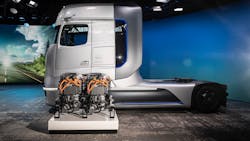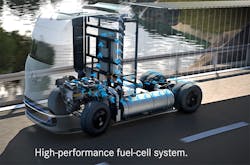Daimler AG reveals fuel cell truck prototype; customer tests begin in 2023
In Berlin on Sept. 16, Daimler Truck AG presented the first look at its Mercedes-Benz GenH2 Truck, a long-haul Class 8 fuel cell electric truck that begins customer testing in 2023 with series production to begin sometime after 2024.
“Our fuel cell is ready,” confirmed Martin Daum, Daimler Truck chairman during the presentation. Daimler AG has been working on the technology, which converts liquid hydrogen to electrical energy, since the late 1990s.
“Depending on the terrain, depending on the form on which the hydrogen is stored, depending on the size of tank, it has a range of 1,000 km (621 miles) and more,” said Daum. “This means it fulfills all requirements in today’s long-haul transport. It’s as performant as our customers expect.”
The cabover style truck will have a 40-ton gross vehicle weight rating and 25-ton payload capacity. The truck will have two 40-kg stainless steel storage tanks for the hydrogen, which will be vacuum-insulated and cooled to -253 degrees C.
The two 150-kw fuel stacks each comprise 200 cells, for a total of 300 kw.
The liquid hydrogen is heated and converted into a gas onboard, which go into the fuel cell, as does oxygen. Through the electrochemical reaction and the use of anodes and cathodes on the oppositely charged atoms, electricity and steam are created.
The electricity then goes to the 70-kWh battery, which powers the e-axle. Sven Ennerst, head of development for Daimler Truck AG, said the battery is expected to provide 230 kw of continuous power and 330 kw of peak power, with no performance fluctuations.
Refueling will be comparable to that of a diesel truck – somewhere between 10 and 15 minutes.
Daum recalled that in 1997, he was tapped to lead the fuel cell team, though he went to take charge of Freightliner in the U.S. instead. He led Daimler Trucks North America (DTNA) until 2017.
He is satisfied that now all the elements for a working fuel cell truck will be place, which include having a “good product,” functioning infrastructure and customers willing to invest.
The next steps are to work with the European Union government, which has strict emission goals guided by the Paris Climate Accords, to create a viable fueling network, promote green hydrogen (processed via renewable means), and possibly implement tolls to keep the technology cost competitive in the near-term with diesel.
The truck itself must undergo 1 million kilometers of road tests and customer testing to find and modify weaknesses and improve durability, Daum added.
One question Daum often gets is why Daimler’s trucks take so long to come out.
“If we bring the vehicles to the market too early then we don’t know how those vehicles will hold up,” Daum continued. “And we always need two winters. In the first winter stuff breaks; in the second winter we can prove this stuff has been fixed.”
The fuel cell development is “very capital intensive” and need high production volumes to make economical sense, Daum said.
“That’s why for us it was a breakthrough when in discussions with the Volvo Group, we realized they had the same issue,” Daum explained. “Volvo [Group] needed a working fuel cell, we needed higher numbers and this is why it was a logical step to work together.”
As such, Daimler and Volvo Group formed a 50/50 joint venture to develop fuel cells earlier this year.
Saving the planet is a “massive undertaking” that “no one can do on their own,” said Martin Lundstedt, the president and CEO of Volvo Group, at the time of that partnership announcement.
Daimler believes fuel cells are the zero-emission answer for long ranges with less routine routes, while battery-electric trucks are better for shorter ranges with repeatable routes.
“We are betting on both battery and fuel cell,” Ennerst said.
The eActros will fulfill this role for Europe starting in 2021, with the 500-km range eActros LongHaul coming in 2024.
When asked for comment on Daimler Trucks North America's fuel cell truck development, the company said: "We are not making any announcement regarding the portfolios of our brands at this time. We will bring hydrogen trucks to the North American market in the future based on our global development efforts, and our previously announced partnership with Volvo Trucks. The complementary technologies of battery electrics and hydrogen fuel cells will both play a part in paving the way to a future of CO₂-neutral commercial vehicle operations."
About the Author
John Hitch
Editor
John Hitch is the editor-in-chief of Fleet Maintenance, providing maintenance management and technicians with the the latest information on the tools and strategies to keep their fleets' commercial vehicles moving. He is based out of Cleveland, Ohio, and was previously senior editor for FleetOwner. He previously wrote about manufacturing and advanced technology for IndustryWeek and New Equipment Digest.


